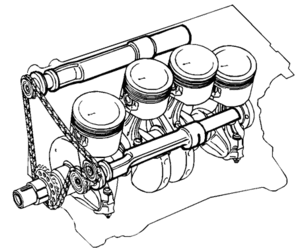NG 900/9-3 Balance Shafts
Contents
Engine vibration
Automotive designers are constantly striving to improve the level of comfort in the car for both driver and passengers. Two key factors here are engine vibration and engine noise, both of which are a product of the basic design of the engine. Through combustion, where chemical energy is converted into mechanical energy, gas forces are generated which act on the piston crown. The reciprocating movement of the pistons and connecting rods, combined with the rotation of the crankshaft, generate inertial forces that act on the engine block and cause it to vibrate in various ways. At low engine speeds the gas forces are greater than the inertial forces but at high engine speeds the converse is true. The most significant forces arise periodically once or twice per crankshaft revolution. They are known as first-order and second-order forces. The first-order inertial forces are completely unbalanced since the crankshaft is balanced and the two piston pairs, 1-4 and 2-3, change direction simultaneously when they reach top dead centre and bottom dead centre.
Second-order forces acting vertically
Inertial forces are generated because both descending pistons in a four-cylinder engine travel further at a given crankshaft angle than the two ascending pistons (the lateral movement of the connecting rods accelerates the descending pistons but delays the ascending pistons). The common centre of gravity of the ascending and descending masses therefore varies, giving rise to forces moving upwards and downwards which vary periodically twice per crankshaft revolution and cause the engine to vibrate in a vertical direction.
Second-order forces acting laterally
During the power stroke the piston is pressed against the cylinder wall due to the angle of the connecting rod relative to the cylinder. At higher engine speeds, however, the inertial force is much greater. It can then be said that the crankshaft pulls the piston down and due to the angle of the connecting rod relative to the cylinder the piston is pressed against the cylinder wall, but this time on the opposite side. Regardless of engine speed, the gas and inertial forces acting sideways vary periodically twice per crankshaft revolution and cause the engine to vibrate in a lateral direction.
The Saab balance shaft system
Saab has used the balance-shaft principle to overcome the second-order inertial forces. Two balance shafts located with lateral symmetry on the sides of the engine block but at different heights above the crankshaft centreline incorporate eccentrically mounted balance weights. The shafts are driven by a chain and rotate in opposite directions to each other at twice the crankshaft speed.
The balance weights on the shafts are positioned so as to eliminate the upward and downward moving forces generated by the movement of the pistons, as described on the preceding page.
Since the balance shafts are situated at different heights above the crankshaft centreline, they also counteract lateral forces. The torque generated by the balance shafts is designed to counteract the gas and inertial forces acting in a sideways direction.
The balance shafts are of identical design and supported by aluminium bearing shells in the centre (between cylinders No. 2 and No. 3). The bearing shells are a press fit in the block and lubricated by special oilways.
For the balance shafts to perform as intended, it is imperative that they are aligned precisely on fitting. Sprocket assemblies of different design for the exhaust and inlet sides are therefore used on the shafts and marked with identifying text.
The balance shaft, sprocket and bearing housing are fitted together as an assembly before being mounted in the correct side of the cylinder block as indicated by the marking on the bearing housing.
Balance shaft drive
The balance shafts are driven by a chain and rotate at twice the crankshaft speed.
A special idler sprocket over which the chain passes causes the balance shaft on the exhaust side to rotate in the opposite direction to the other balance shaft. The chain is located by two fixed chain guides and a pivoted chain guide on which a chain tensioner acts.
When the engine is running, pressurized engine oil acts on the chain tensioner in the opposite direction to control the force applied to the chain and so reduce both chain wear and chain noise to a minimum.
Both the balance-shaft sprockets and the idler sprocket incorporate thrust rings to reduce chain noise still further.
The thrust rings absorb the force of the chain where it engages the sprocket teeth, ensuring smoother operation and quieter running.
Due to the smaller surface contact angle, the thrust rings on the exhaust side are larger than those on the inlet side.
